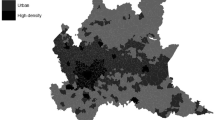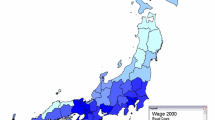Abstract
This paper analyzes the existence of efficiency wages in the French and Spanish labor markets, within an urban efficiency wage theoretical framework. Using data from the French and Spanish time use surveys for the year 2009–2010, results support the main hypothesis of urban efficiency wage models. In particular, that leisure and shirking at work are substitutes, that there is a negative relationship between commuting and leisure, and that there are positive relationships between commuting-shirking at work and commuting-earnings. These results represent the second test of this relationship in the literature, and the first empirical estimate of these relationships for France and Spain. The results show the existence of a direct link between commuting and earnings, which may be helpful in improving the functioning of labor markets.
Similar content being viewed by others
Notes
Urban efficiency wages models do not consider the possible existence of monopsony in labor markets (Manning, 2003). Monopsony is characterized by the presence of many individuals looking for work and only a few employers, who can afford to offer a lower salary than they would have to offer if there was more competition for workers. Furthermore, trade unions can provide a counterweight to bargaining power and the unilateral exercise of monopsonic power, promoting higher wages. Thus, with monopsony, the theoretical relationship between commuting and wages may not be as positive as expected.
More information at https://www.insee.fr/en/metadonnees/source/serie/s1224; and at https://www.ine.es/prensa/eet_prensa.htm.
The FTUS and STUS are based on diaries, so they can be used to compute the time devoted to different activities in 10-minute bands. In these time bands, apart from the main activity reported by respondents, there is information on the place where activities are taking place, including the workplace, which allows us to compute the time at the workplace that is not reported as market work.
Results are sensitive to the inclusion of “work breaks” and “meals at work” in the definition of shirking at work.
The FTUS does not include information on worker occupation, but it does include information on worker industry, in terms of the NACE 2 classification. We use this classification and, for the sake of simplicity and consistency, refer to the industry in which employees work as “occupation”.
The datasets do not include the required information to replicate the employment analysis of Gimenez-Nadal, Molina and Velilla (2018), as housing stock variables, or other variables required to instrument commutes are not included.
The vector \(X_{i}\) of socio-demographic controls includes being male, age and its square, secondary education, university education, being native, living in couple, having children, and family size. In the case of France information on regions is not available, and thus the equations include only occupation fixed effects. Robust standard errors are clustered at the regional (NUTS-2) and occupation level for Spain, and at the occupation level in France.
Commuting time may be different for different type of workers, as they may, for instance, be selected into different occupations according to their characteristics (e.g., more educated workers are more likely to be in non-supervised occupations) or have different preferences for leisure (Hamermesh and Lee, 2007). For this reason, we regress (log of) commuting time on the set of socio-demographic characteristics (Xi) defined in Eqs. (1) to (4) plus occupation fixed effects, by supervision level. The results are shown in Table 6 in the “Appendix”, and the coefficients are in general terms not significant at standard levels, and R-squared statistics are quite low, which is in line with a number of studies suggesting that commuting is a magnitude that depends on stochastic and non-controllable factors, such as weather conditions and traffic congestion (see Gimenez-Nadal, Molina and Velilla, 2020) for a review.
Note that monthly earnings are missing for 906 Spanish employees, who are omitted from the analysis shown in Table 5.
We have also estimated a regression of log hours worked, where we include the same explanatory variables as in the previous regressions, the log-of-shirking time, and a dummy for non-supervised workers. Table 7 in the “Appendix” shows the results of estimating this regression. We first find, for both France and Spain, a statistically significant and positive correlation between being a supervised worker and market work time, which suggests that unsupervised workers work shorter hours. Furthermore, after controlling for the supervision level, the elasticity between market work time and shirking at work is positive and statistically significant, indicating that market work hours and shirking are positively related. However, these results may be biased due to reverse causality issues, and must be taken with caution.
References
Aguiar M, Hurst E. Measuring trends in leisure: the allocation of time over five decades. Quart J Econ. 2007;122(3):969–1006.
Alonso W. Location and land use. Harvard: Harvard University Press; 1964.
Bianchi SM, Milkie MA, Sayer LC, Robinson JP. Is anyone doing the housework? Trends in the gender division of household labor. Soc Forces. 2000;79(1):191–228.
Blau, F. D., and Kahn, L. M. (2016). The gender wage gap: Extent, trends, and explanations. IZA DP No. 9656.
Bonke J. Paid work and unpaid work: diary information versus questionnaire information. Soc Indic Res. 2005;70(3):349–68.
Brueckner JK, Zenou Y. Space and unemployment: the labor market effects of spatial mismatch. J Labor Econ. 2003;21(1):242–62.
Burda MC, Genadek KR, Hamermesh DS. Not working at work: Loafing, unemployment and labor productivity. IZA DP 9095;2015.
Craig L. Is there really a second shift, and if so, who does it? A time-diary investigation. Femin Rev. 2007;86:149–70.
Dargay JM, Clark S. The determinants of long distance travel in Great Britain. Transp Res Part A: Policy Pract. 2012;46(3):576–87.
Dickerson A, Hole AR, Munford LA. The relationship between well-being and commuting revisited: does the choice of methodology matter? Region Sci Urban Econ. 2014;49:321–9.
Fleisher BM, Wang X. Efficiency wages and work incentives in urban and rural China. J Comp Econ. 2001;29(4):645–62.
Frey BS, Stutzer A. Stress that doesn’t pay: the commuting paradox. Scand J Econ. 2008;110(2):339–66.
Fu S, Ross SL. Wage premia in employment clusters: How important is worker heterogeneity? J Labor Econ. 2013;31(2):271–304.
Garreau J. Edge city: life on the new frontier. New York: Doubleday; 1991.
Gershuny J. Changing times, work and leisure in post industrial society. Oxford: Oxford University Press; 2000.
Gimenez-Nadal JI, Molina JA. Regional unemployment, gender, and time allocation of the unemployed. Rev Econ Household. 2014;12(1):105–27.
Gimenez-Nadal JI, Molina JA, Velilla J. Spatial distribution of US employment in an urban efficiency wage setting. J Region Sci. 2018;58(1):141–58.
Gimenez-Nadal JI, Molina JA, Velilla J. Modelling commuting time in the US: bootstrapping techniques to avoid overfitting. Pap Region Sci. 2020;98(4):1667–84.
Gimenez-Nadal JI, Sevilla A. The time-crunch paradox. Soc Indic Res. 2012;102:181–96.
Gobillon L, Selod H, Zenou Y. The mechanisms of spatial mismatch. Urban Stud. 2007;44(12):2401–27.
Gottholmseder G, Nowotny K, Pruckner GJ, Theurl E. Stress perception and commuting. Health Econ. 2009;18(5):559–76.
Grinza E, Rycx F. The impact of sickness absenteeism on firm productivity: new evidence from Belgian matched employer-employee panel data. Ind Rel. 2020;59(1):150–94.
Guryan J, Hurst E, Kearney M. Parental education and parental time with children. J Econ Perspect. 2008;22(1):23–46.
Hamermesh, D. S. (1990). A general model of dynamic labor demand. National Bureau of Economic Research paper No. w3356.
Hamermesh DS. The timing of work over time. Econ J. 1999;109(452):37–66.
Hamermesh DS, Lee J. Stressed out on four continents: time crunch or yuppie kvetch? Rev Econ Stat. 2007;89(2):374–83.
Hamermesh DS, Stancanelli E. Long workweeks and strange hours. ILR Rev. 2015;68(5):1007–18.
Hansson E, Mattisson K, Bjork J, Ostergren P-O, Jakobsson K. Relationship between commuting and health outcomes in a cross-sectional population survey in southern Sweden. BMC Pub Health. 2011;11(1):834.
Harms T, Berrigan D, Gershuny J. Daily metabolic expenditures: estimates from US, UK and polish time-use data. BMC Pub Health. 2019;19(2):453.
Jara-Díaz S, Rosales-Salas J. Understanding time use: daily or weekly data? Transp Res Part A: Police Pract. 2015;76(1):38–57.
Juhn C, McCue K. Specialization then and now: marriage, children, and the gender earnings gap across cohorts. J Econ Perspect. 2017;31(1):183–204.
Kahneman D, Krueger AB. Developments in the measurement of subjective well-being. J Econ Perspect. 2006;20(1):3–24.
Kahneman D, Krueger AB, Schkade DA, Schwarz N, Stone AA. A survey method for characterizing daily life experience: the day reconstruction method. Science. 2004;306(5702):1776–80.
Killewald A. A reconsideration of the fatherhood premium: marriage, coresidence, biology, and fathers’ wages. Am Soc Rev. 2012;78(1):96–116.
Kimmel J, Connelly R. Mothers’ time choices caregiving, leisure, home production, and paid work. J Hum Resour. 2007;42(3):643–81.
Kirby DK, LeSage JP. Changes in commuting to work times over the 1990 to 2000 period. Region Sci Urban Econ. 2009;39(4):460–71.
Knox PL, McCarthy L. Urbanization: an introduction to Urban Geography. 2005;Prentice Hall.
Künn-Nelen A. Does commuting affect health? Health Econ. 2016;25(8):984–1004.
Kunze, A. The effect of children on male earnings and inequality. Rev Econ Household. 2019;forthcoming.
Leigh JP. Are compensating wages paid for time spent commuting? Appl Econ. 1986;18:1203–13.
Levenson A, Zoghi C. The strength of occupation indicators as a proxy for skill. CEO Public 2006;G06-17 (506).
Lundberg S, Rose E. Parenthood and the earnings of married men and women. Lab Econ. 2000;7:689–710.
Lundberg S, Rose E. The effects of sons and daughters on men’s labor supply and earnings. Rev Econ Stat. 2002;84(2):251–68.
Manning A. Monopsony in motion. Princeton, NJ: Princeton University Press; 2003.
Mattingly MJ, Sayer LC. Under pressure: gender differences in the relationship between free time and feeling rushed. J Marr Fam. 2006;68(1):205–21.
McQuaid RW, Chen T. Commuting times: the role of gender, children and part-time work. Res Transp Econ. 2012;34(1):66–73.
Mills ES. An aggregative model of resource allocation in a metropolitan area. Am Econ Rev. 1967;57(2):197–210.
Muller PO. Contemporary suburban America. NJ: Prentice Hall; 1981.
Muth RF. Cities and housing: the spatial pattern of urban residential land use. Chicago: University of Chicago Press; 1969.
Novaco RW, Gonzalez OI. Commuting and well-being. In: Amichai-Hamburger Y, editor. Technology and psychological well-being. Cambridge: Cambridge University Press; 2009. p. 174–205.
OECD. The pursuit of gender equality: an uphill battle. Paris: OECD Publishing; 2017.
Patacchini E, Zenou Y. Spatial dependence in local unemployment rates. J Econ Geogr. 2007;7(2):169–91.
Picard PM, Zenou Y. Urban spatial structure, employment and social ties: European versus American cities. IZA DP 9166;2015.
Ross SL, Zenou Y. Are shirking and leisure substitutable? An empirical test of efficiency wages based on Urban Economic Theory. Region Sci Urban Econ. 2008;38(5):498–517.
Ruppert P, Stancanelli E, Wasmer E. Commuting, wages and bargaining power. Ann Econ Stat. 2016;95/96:1.
Sevilla A, Gimenez-Nadal JI, Gershuny J. Leisure inequality in the United States: 1965–2003. Demography. 2012;49(3):939–64.
Shapiro C, Stiglitz JE. Equilibrium unemployment as a worker discipline device. Am Econ Rev. 1984;74(3):433–44.
Stone AA, Schneider S. Commuting episodes in the United States: their correlates with experiential wellbeing from the American Time Use Survey. Transp Res Part F: Traff Psychol Behav. 2016;42(1):117–24.
Van Ommeren JN, Gutierrez-i Puigarnau E. Are workers with a long commute less productive? An empirical analysis of absenteeism. Region Sci Urban Econ. 2011;41(1):1–8.
Wener RE, Evans GW, Phillips D, Nadler N. Running for the 7:45: the effects of public transit improvements on commuter stress. Transportation. 2003;30(2):203–20.
White MJ. Urban areas with decentralized employment: theory and empirical work. Handb Region Urban Econ. 1999;3:1375–412.
Yee-Kan M. Measuring housework participation: the gap between “stylized” questionnaire estimates and diary-based estimates. Soc Indic Res. 2008;86(3):381–400.
Zax JS. Compensation for commutes in labor and housing markets. J Urban Econom. 1991;30(2):192–207.
Zenou Y. Efficiency wages and unemployment in cities: the case of high-relocation costs. Region Sci Urban Econ. 2006;36(1):49–71.
Zenou Y. Urban labor economics. Cambridge: Cambridge University Press; 2009.
Zenou Y, Smith TE. Efficiency wages, involuntary unemployment and urban spatial structure. Regional Science and Urban Economics. 1995;25(4):547–73.
Author information
Authors and Affiliations
Corresponding author
Additional information
Publisher's Note
Springer Nature remains neutral with regard to jurisdictional claims in published maps and institutional affiliations.
Appendix A: Additional results
Appendix A: Additional results
See Tables 6, 7, 8, 9, 10, 11, 12 and 13.
Rights and permissions
About this article
Cite this article
Giménez-Nadal, J.I., Molina, J.A. & Velilla, J. Testing urban efficiency wages in France and Spain. Empir Econ 61, 2205–2236 (2021). https://doi.org/10.1007/s00181-020-01928-x
Received:
Accepted:
Published:
Issue Date:
DOI: https://doi.org/10.1007/s00181-020-01928-x




